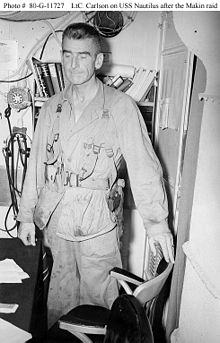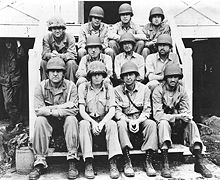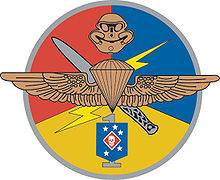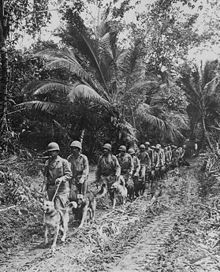- Marine Raiders
-
 Marine Raider insignia.
Marine Raider insignia.
The Marine Raiders were elite units established by the United States Marine Corps during World War II to conduct amphibious light infantry warfare, particularly in landing in rubber boats and operating behind the lines. "Edson's" Raiders of 1st Marine Raiders Battalion and "Carlson's" Raiders of 2nd Marine Raiders Battalion are said to be the first United States special operations forces to form and see combat in World War II.
Four Raider battalions served operationally but all were disbanded on 8 January 1944 when the Corps made the doctrinal decision that the Raiders had out-lived their original mission. The changing nature of the war in the Pacific, with many large-scale amphibious assaults to come against well-defended islands, negated the requirements for small light units that could strike deep into enemy territory.
However, most combat operations saw the Raiders employed as regular infantry, and combined with the resentment within the rest of the Marines that the Raiders were an "elite force within an elite force", led to the eventual abandonment of the experiment.
On 1 February the 1st Raider Regiment was redesignated the 4th Marine Regiment, thus assuming the lineage of the regiment that had garrisoned Shanghai in the interwar years and fought so gallantly on Bataan and Corrigedor. The 1st, 3rd, and 4th Raider Battalions became respectively the 1st, 3rd, and 2nd Battalions of the 4th Marines. The 2nd Raider Battalion filled out the regimental weapons company. Personnel in the Raider Training Center transferred to the newly formed 5th Marine Division. Leavened with new men, the 4th Marines went on to earn additional distinctions in the assaults on Guam and Okinawa. At the close of the war, the regiment joined the occupation forces in Japan and participated in the release from POW compounds of the remaining members of the old 4th Marines.
Contents
History
Provisional Rubber Boat Companies
One of the deficiencies of the Fleet Marine Force was a lack of fast transport ships that could keep up with a Naval fleet. Until fast attack transports entered the Navy, either the fleet would have to keep its speed down to the speed of the transport ships, or the fleet would have to split in two components; neither option was desirable. With the start of World War II in 1939, a group was formed to come up with a solution that could be rapidly implemented. The group found a large number of destroyers built for the First World War that were in the mothball fleet. These destroyers had four boilers and four smoke stacks and were fast enough to keep up with the fleet. The group discovered that by removing two boilers and smoke stacks room could be found to quarter a company of 130 Marines who would be landed by inflatable boats.[1] These high speed transports were named APDs by the Navy. The APDs later had four Higgins boats attached to them.
In February 1941 one company ("A", "E" and "I") of the recently formed 7th Marines were designated "Provisonal Rubber Boat Companies" and participated in a Fleet Landing Exercise (FLEX-7) in 1941.[2] After the exercise, General Holland Smith assigned the APDs and rubber boat function to the 1st Battalion 5th Marines.[3]
Creation
With America thrust into the war, the President became interested in creating an American counterpart to the British Commandos and the Marine Corps was the natural place for this organization. Indeed, the commanding general of the 2nd Marine Division initially proposed the name "Marine Commandos". The Commandant of the Marine Corps, Major General Thomas Holcomb, was of the opinion, however, that "the term 'Marine' is sufficient to indicate a man ready for duty at any time, and the injection of a special name, such as 'Commando,' would be undesirable and superfluous." General Holcomb redesignated the 1st Battalion 5th Marines as the "1st Separate Battalion" and created the 2nd Separate Battalion to be commanded by Carlson in response to pressure from the President.
The debate over the creation of these elite units came to a climax when the new commander of the Pacific Fleet, Admiral Chester Nimitz, requested "commando units" for raids against lightly defended Japanese-held islands. The commandant selected the term "Raiders" and created two battalions. The 1st Raider Battalion was activated on 16 February 1942, followed by the 2nd Raider Battalion on February 19. Carlson was given a promotion to Lieutenant Colonel and placed in command of the 2nd Raiders, and Lt. Col. (later, Major General) Merritt A. "Red Mike" Edson, command of the 1st.
The Raiders were created by an order from President Franklin D. Roosevelt, acting on proposals from Colonel William J. Donovan and Major Evans F. Carlson. Carlson had been a soldier in the Punitive Expedition to capture Pancho Villa in Mexico and World War I, became a Marine officer during the American occupation of Nicaragua, and served as an Intelligence Officer of the 4th Marines in China. He had seen the tactics and strategy of Communist Chinese irregulars, Zhū Dé and the Eighth Route Army in particular, as they fought the occupying Japanese and became enthralled with their version of guerrilla warfare. In 1933 Carlson had commanded the Marine Detachment at the Warm Springs, Georgia vacation retreat of President Roosevelt, where he formed a close friendship with both Franklin D. Roosevelt and his son James. Carlson resigned from the Marines to speak to American businessmen to warn them against providing materials to Japan. Carlson rejoined the Marines in April 1941, gaining a commission from the Commandant as a reserve major. Carlson still had the President's ear as well as FDR's son James Roosevelt, who was now a Marine Captain and was his friend and protégé.
The Raiders were given the best of the Marines' equipment, and were handpicked from available volunteers. The two units approached their common mission from different directions. Carlson utilized egalitarian and team-building methods learned from the Communists during his years in China: he treated officers and enlisted men with minimum regard to rank as leaders and fighters, gave his men "ethical indoctrination," describing for each man what he was fighting for and why, and used the Chinese phrase "Gung-ho!" as a motivational slogan. He also eschewed standard Marine Corps organization, forming six rifle companies of two platoons each, and innovating 3-man "fire teams" as its basic unit.[4] Edson's battalion, however, more closely followed standard Marine Corps doctrine in training, organization, and discipline.
Combat in the Central Pacific and Solomons
Both Raider battalions were put into action at roughly the same time. On 7 August 1942, Edson's 1st Raider Battalion, assigned to the 1st Marine Division, landed on Tulagi in the British Solomon Islands Protectorate as the opening phase of the Guadalcanal Campaign. After the capture of Tulagi, the Raiders were moved to Guadalcanal to defend Henderson Field. One of their most notable engagements was the "Battle of Edson's Ridge", where the 1st Raiders, remnants of the 1st Parachute Battalion, and the 2nd Battalion 5th Marines scored a major defensive victory over Imperial Japanese Army forces on the night of September 13–14. Out of the action both Edson and Major Kenneth D. Bailey were awarded the Medal of Honor, the latter posthumously.
Carlson's 2d Raider Battalion boarded the submarines Nautilus (SS-168, Cdr William H. Brockman, Jr.) and Argonaut (APS-1, Cdr John R. "Jack" Pierce) and raided Makin Island on August 17–18. During the raid, Sergeant Clyde A. Thomason was posthumously awarded the Medal of Honor and was the first Marine recipient of this honor during World War II.[5] Unfortunately, nine men were unintentionally left on the island when the Raiders returned to the submarines. These men were captured and later beheaded at Kwajalein.[6]
After the Battle of Savo Island, 1400 men in various support units of the 2nd Marine Regiment who had not yet landed on Tulagi were returned to Espiritu Santo after the transports they were on were withdrawn from the area. Deeming them "idle Marines", Admiral Richmond K. Turner decided to form them into a "2nd Provisional Raider Battalion" without consulting the Commandant of the Marine Corps.[7] The unit was ordered created on 29 August 1942 but the order was superseded on 28 September 1942 by theater commander Admiral Robert L. Ghormley.[8] Admiral Turner believed that regimental or larger sized Marine units were not suitable for Marine amphibious forces and desired that all Marine battalions be re-formed as Raider battalions,[7] which may have influenced the Marine Corps to take a dim view of the entire Raider concept.
In the fall of 1942, two additional Raider battalions were created; the 3rd Raiders in Samoa, commanded by Lt. Col. Harry B. Liversedge, and the 4th Raiders at Camp Pendleton, California, commanded by now-Lt. Col. James Roosevelt. These battalions distinguished themselves in heavy combat alongside the 1st and 2d Raiders in the 1943 campaigns in the upper Solomons. On March 15, 1943, the four battalions were organized as the 1st Marine Raider Regiment at Espiritu Santo, with Liversedge as commander and Carlson as executive officer. Lt Col Alan Shapley was named commander of the 2nd Raiders a week later and immediately returned it to a standard organization.[9]
The 1st Raider Regiment enforced a common organization among the battalions. Each had a weapons company, and four rifle companies composed of three rifle platoons and a weapons platoon. The result reflected a mixture of Edson's and Carlson's ideas. Carlson's 3-man fire team and 10-man squad organizations were adopted, first by the Raiders and then by the entire Marine Corps. Edson contributed the concept of a highly trained, lightly equipped force using conventional tactics to accomplish special missions or to fill in for a line battalion.[9]
During the New Georgia Campaign, the 1st Marine Raider Regiment was reorganized, consisting of the 1st and 4th Raiders, and two battalions of the 37th Infantry Division, commanded by Liversedge.[10] At the same time, the 2nd and 3rd Raider Battalions were organized as the 2nd Marine Raider Regiment (Provisional) under Shapley, for the invasion of Bougainville, the final combat action of the Raiders before their dissolution.[11] PFC Henry Gurke of the 3rd Raider Battalion was awarded the Medal of Honor for actions of 6 November 1943, on Bougainville.
In December 1943 command of the 1st Raider Regiment passed to Lieutenant Colonel Samuel D. Puller. The regiment left New Caledonia on 21 January and landed on Guadalcanal three days later. The provisional 2d Raider Regiment disbanded and rejoined into the 1st, with the senior Shapley in command and Puller the executive officer.
Disbandment
In early 1944 the Marine Corps had four divisions, with two more being formed. Even with nearly a half million Marines in service, the Corps had insufficient manpower to allocate to the new divisions, because of large numbers of men assigned to defense, parachute, raider, barrage balloon, amphibious tractor and other specialized units. With no further expansion of the Corps planned, the only way to add manpower to the new divisions was to obtain it from existing organizations.
The anticipated need for commando-type units had not materialized, and the development of the amphibious tractor and improved fire support had ended the need for light assault units. The Raiders had generally performed the same missions as line infantry battalions, either wasting their training and skills, or exposing the lightly armed Raiders to excessive casualties. There was also institutional opposition to the existence of an elite force within the already elite Corps. Two senior officers who had been opposed to the Raiders on this basis advanced to positions where they could abolish the units. On 1 January 1944, Gen. Alexander Vandegrift became Commandant of the Marine Corps, and Gen. Gerald C. Thomas became the Director of Plans and Policies.
The previous Director of Plans and Policies had already proposed to disband the Raiders and the Paramarines as "handpicked outfits...detrimental to morale of other troops." Admiral Ernest King, Chief of Naval Operations, concurred in the proposal, and Vandegrift ordered the change on 8 January 1944. Manpower from the deleted units and their stateside training establishments were redirected to the new divisions, and supply requirements were simplified by the increased uniformity. On 1 February, the 1st Raider Regiment was redesignated the 4th Marine Regiment, and eventually became part of the 6th Marine Division. The 1st, 4th, and 3d Raider Battalions became respectively the 1st, 2d, and 3d Battalions, 4th Marines. The 2d Raider Battalion became the regimental weapons company. Personnel of the Raider Training Battalion at Camp Pendleton transferred to the 5th Marine Division.
During the war, a total of 8,078 men, including 7,710 Marines and 368 sailors, were assigned to Raider units. Raiders received a total of seven Medals of Honor and 136 Navy Crosses.[12]
Post World War II
According to the Marine Corps Times, the 20 June 2003 activation of the Marine Corps Forces Special Operations Command, which began with Detachment One, paid homage to the Marine Raiders. The Detachment's insignia, designed by Gunnery Sergeant Anthony Siciliano, incorporated the Raiders’ famous knife, the United States Marine Raider Stiletto, and the Raiders’ insignia as a tribute and link to the famed battalions, which existed for only two years after their 1942 inception. When they went into combat in Iraq, as part of a Navy SEAL task group, Detachment One called itself Task Unit Raider. However, use of the name has now ended; Marine Corps officials have decided that Marines and units in the new Marine Corps Special Operations Command, which was stood up in February 2006, will not be called Raiders.[12]
Commanding officers
1st Marine Raider Battalion
- Lt. Col./Col. Merritt A. Edson (February - September 1942)
- Lt. Col. Samuel B. Griffith (September 1942 - September 1943)
- Maj. George W. Herring (September - October 1943)
- Maj. Charles L. Banks (October 1943 - February 1944)
2nd Marine Raider Battalion
- Lt. Col. Evans Carlson (February 1942 - March 1943)
- Lt. Col. Alan Shapley (March - August 1943)
- Lt. Col. Joseph P. McCaffery (September - November 1943)
- Maj. Richard T. Washburn (November 1943 - January 1944)
3rd Marine Raider Battalion
- Lt. Col. Harry B. Liversedge (September 1942 - March 1943)
- Lt. Col. Samuel S. Yeaton (March - June 1943)
- Lt. Col. Fred D. Beans (June 1943 - January 1944)
- Maj. Ira J. Irwin (January 1944)
4th Marine Raider Battalion
- Lt. Col. James Roosevelt (October 1942 - April 1943)
- Maj. James R. Clark (April - May 1943)
- Lt. Col. Michael S. Currin (May - September 1943)
- Maj. Robert H. Thomas (September 1943 - February 1944)
1st Marine Raider Regiment
- Col. Harry B. Liversedge (March - December 1943)
- Lt. Col. Samuel D. Puller (December 1943 - January 1944)
2nd Marine Raider Regiment
- Lt. Col. Alan Shapley (September 1943 - January 1944)
Marine Raider Medal of Honor recipients
- Maj. Kenneth D. Bailey (1910–1942), 1st Raider Battalion
- Cpl. Richard E. Bush (1924–2004), 1st Raider Battalion
- Lt. Col. Justice M. Chambers (1908–1982), while serving with 3rd Battalion 25th Marines
- Col. Merritt A. Edson (1897–1955), 1st Raider Battalion
- Pfc. Henry Gurke (1922–1943), 3rd Raider Battalion
- Sgt. Clyde A. Thomason (1914–1942), 2nd Raider Battalion
- GySgt. William G. Walsh (1922–1945), while serving with 3rd Battalion 27th Marines
Marine Raiders in popular culture
Film
- Walter Wanger's 1943 film Gung Ho! is a depiction of the 2nd Raider Battalion's raid on Makin Island. Though Carlson and his executive officer James Roosevelt are not depicted in the film, Sam Levine plays Victor "Transport" Maghikian (who acted as an adviser on the film) and J. Carrol Naish plays a character based on Lieutenant John Apergis who was in the unit but not on Makin. Randolph Scott played the role of the battalion commander. Carlson acted as a technical advisor and several actual members of the Makin Island raid appear in the film.
- RKO's 1944 film Marine Raiders is a fictional account of the 1st Raider Battalion on Guadalcanal, on leave in Australia, then on Bougainville (where the 2nd and 3rd Raiders actually participated). Pat O'Brien played the fictional commander of the 1st Raider Battalion with Robert Ryan portraying a Paramarine captain.
- Baby Blue Marine (1976) features Jan Michael Vincent who fails to complete Marine basic training and is sent home wearing a baby blue uniform. He is mugged by a war weary Marine Raider played by Richard Gere for his uniform.
Video games
- Electronic Arts' Medal of Honor: Pacific Assault follows a squad of Marine Raiders from the Makin Island raid to the Battle of Tarawa
- Activision's Call of Duty: World at War begins with the rescue of player character Private Miller by other Marine Raiders during the Makin Island raid. The game then skips ahead two years to find Miller and his squadmates assigned to the 1st Marine Division during the Battle of Peleliu and, later, the Battle of Okinawa.
Books
- W.E.B. Griffin's novel Call To Arms, Book Two of The Corps series, focuses on the forming of the Marine Raiders and the raid on Makin Island, as told through the novel's protagonist, Lt. Kenneth 'Killer' McCoy.
- Bobby Shaftoe, one of the main characters in the portions of the Neal Stephenson novel Cryptonomicon set in World War II, is a Marine Raider.
- Leon Uris' book Battle Cry makes mention of Coleman's Raiders fighting on Guadalcanal, and later on in the book there is a minor story arc featuring a former Raider, Captain Max "Two Gun" Shapiro.
See also
- List of United States Marine Corps battalions
- United States Marine Corps Force Reconnaissance
- United States Marine Raider Stiletto
- Former United States special operations units
- Marine Raider Museum
Notes
- ^ p. 14 Alexander, Joseph H. Edson's Raiders: The 1st Marine Raider Battalion in World War II 2000 US Naval Institute Press
- ^ p.47 Rottman, Gordon L. US Special Warfare Units in the Pacific Theater 1941-45: Scouts, Raiders, Rangers and Reconnaissance Units 2005 Osprey Publishing
- ^ p.15 Alexander
- ^ Hoffman, Major Jon T, (USMCR). "Shaping the Raiders" (Marines in World War II Commemorative Series). From Makin to Bougainville: Marine Raiders in the Pacific War. Marine Corps History and Museums Division. http://www.nps.gov/archive/wapa/indepth/extContent/usmc/pcn-190-003130-00/sec2.htm. Retrieved 27 June 2008.
- ^ Rottman (2005). Pages 60–61.
- ^ Smith, G.W. (2001). Carlson's Raid. Presidio Press. ISBN 0-89141-744-3.
- ^ a b "Chapter 2, Guadalcanal", Lt Col Frank O. Hough (USMCR) et. al., History of the U.S. Marine Corps in World War II: Pearl Harbor to Guadalcanal.
- ^ Rottman (2005), p.62-63.
- ^ a b Hoffman, Major Jon T, USMCR. "Reshaping the Raiders" (Marines in World War II Commemorative Series). From Makin To Bougainville: Marine Raiders in the Pacific War. Marine Corps History and Museums Division. http://www.nps.gov/archive/wapa/indepth/extContent/usmc/pcn-190-003130-00/sec10.htm. Retrieved 24 November 2009.
- ^ Rentz, Major John M, USMC. "Appendix IV Command and Staff List" (USMC Historical Monograph). Marines in the Central Solomons. Hyper War Foundation. http://www.ibiblio.org/hyperwar/USMC/USMC-M-CSol/USMC-M-CSol-IV.html. Retrieved 24 November 2009.
- ^ Rentz, Major John M, USMC. "Appendix VI Task Organization" (USMC Historical Monograph). Bougainville and the Northern Solomons. Hyper War Foundation. http://www.ibiblio.org/hyperwar/USMC/USMC-M-NSols/USMC-M-NSol-VI.html. Retrieved 24 November 2009.
- ^ a b Fuentes, Gidget; Gina Cavallaro (2011-02-28). "No Return Of The Raiders". Marine Corps Times: p. 21. http://www.marinecorpstimes.com/news/2011/03/marine-marsoc-raiders-rename-030711w/. Retrieved 2011-03-22.
References
- Bibliography
- Alexander, Joseph H (2000). Edson's Raiders: The 1st Marine Raider Battalion in World War II. Annapolis, Maryland: Naval Institute Press. ISBN 9781557500205.
- McCormick, John (1994) (Novel). The Right Kind of War. Onyx. ISBN 9780451404503.
- Rottman, Gordon (2005). US Marine Corps Pacific Theater of Operations 1944-45. Oxford: Osprey Publishing.
- Rottman, Gordon L. U.S. Marine Corps World War II Order of Battle - Ground and Air Units in the Pacific War, 1939 - 1945. Greenwood Press, 2002. ISBN 0-313-31906-5.
- Smith, George W. (2001). Carlson's Raid: The Daring Marine Assault on Makin. Novato, California: Presidio Press. ISBN 9780891417446.
- Updegraph, Charles L., Jr. (1972). U.S. Marine Corps Special Units of World War II. Washington, D.C.: Historical Division, Headquarters, United States Marine Corps. PCN 190 002596 00.
External links
- Marine Raider Medal of Honor Recipients, MedalofHonor.com.
- US Marine Raiders Official Website
- Gung Ho! at the Internet Movie Database
- U.S. Marine Raiders - Roll of honor, awards and images.
- USMC Raider Battalions
Categories:- Marine Raiders
- Inactive units of the United States Marine Corps
- Military units and formations established in 1942
- Military units and formations disestablished in 1944
- United States Marine Corps in World War II
Wikimedia Foundation. 2010.





